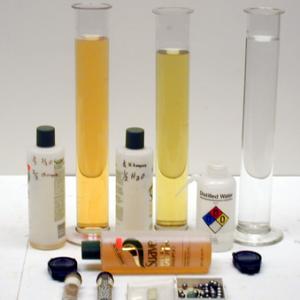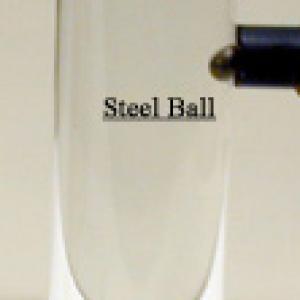College of Liberal Arts & Sciences
2C30.50 - Terminal Velocity
Place water in one of the cylinders and the pump oil in the other. Light objects dropped into the oil should reach a definite terminal velocity which will not be apparent in a water column of the same height. Do not try this with heavy objects as they may reach a velocity great enough to break the bottom of the glass column. Dishwashing detergents and shampoos will work for this demonstration but you will want to chose only those in which you can see objects clearly.
- Maarij Syed and N. Nuessle, "What a Metal Pipe Can Teach You About Magnetism", TPT, Vol. 57, #5, May 2019, p. 330.
- Elida de Obaldia, Norma Miller, Fred Wittel, George Jaimison, and Kendra Wallis, "Bridging the Conceptual Gap Between Free Fall and Drag-Dominated Regimes", TPT, Vol. 54, #4, Apr. 2016, p. 233.
- Matthew T. Mawhinney, Mary Kate O-Donnell, Jonathan Fingerut, and Piotr Habdas, "Measuring Drag Force in Newtonian Liquids", TPT, Vol. 50, #3, Mar. 2012, p. 173.
- Pirooz Mohazzabi, "Falling and Rising in Water", TPT, Vol. 48, #7, Oct. 2010, p. 478.
- J. Costa Leme, C. Moura, and Cintia Coste, "Steel Spheres and Skydiver - Terminal Velocity", TPT, Vol. 47, #8, Nov. 2009, p. 531.
- Howard Brand, "Action-Reaction at a Distance", TPT, Vol. 40, #3, Mar. 2002, p. 136.
- Roger Blickensderfer, "Is the Water Safe to Drink?", TPT, Vol. 34, #2, Feb. 1996, p. 83.
- John H. Dodge, "Fluid Resistance and Terminal Velocity", TPT, Vol. 30, #7, Oct. 1992, p. 420.
- Metin Yersel, "A Simple Demonstration of Terminal Velocity", TPT, Vol. 29, #6, Sept. 1991, p. 334.
- C. W. Tompson and J. L. Wragg, "Terminal Velocity on an Air Track", TPT, Vol. 29, # 3, Mar. 1991, p. 178.
- Ernest Zebrowski, Jr., "Superterminal Velocities", TPT, Vol. 27, #8, Nov. 1989, p. 618.
- Paul Hewitt, "Figuring Physics", TPT, Vol. 26, #2, Feb. 1988, p. 118.
- Carl C. Fields, "Swimming in Europa's Ocean", TPT, Vol. 25, #8, Nov. 1987, p. 508.
- Kelly Locke and Jim Nelson, "About Terminal Velocity", TPT, Vol. 22, #4, Apr. 1984, p. 256.
- A. Muriel, "'Mighty-Mo' Mechanics", TPT, Vol. 16, #3, Mar. 1978, p. 160.
- John Dowd, "Erratum: 'An Interactive Computer Experiment for the Introductory Laboratory'", AJP, Vol. 46, #10, Oct. 1978, p. 1078.
- John Dowd, "An Interactive Computer Experiment for the Introductory Laboratory", AJP, Vol. 46, #1, Jan. 1978, p. 63.
- Freier and Anderson, "Fm-1", A Demonstration Handbook for Physics.
- II. Stokes' Law Demonstration: Free Help From the Drug-Store.
- W. Bolton, "13. Determination of Particle Size", Book 1 - Properties of Materials, Physics Experiments and Projects, 1968, p. 72 - 73.
- W. Bolton, "12. Terminal Velocities of Rain Drops", Book 1 - Properties of Materials, Physics Experiments and Projects, 1968, p. 71 - 72.
- W. Bolton, "10. Terminal Velocity", Book 1 - Properties of Materials, Physics Experiments and Projects, 1968, p. 17 - 18.
- W. Bolton, "Specimen Project", Book 1 - Properties of Materials, Physics Experiments and Projects, 1968, p. xi - xvi.
- Borislaw Bilash II, “Viscosity“, A Demo A Day – A Year of Physical Science Demonstrations, p. 101.
Disclaimer: These demonstrations are provided only for illustrative use by persons affiliated with The University of Iowa and only under the direction of a trained instructor or physicist. The University of Iowa is not responsible for demonstrations performed by those using their own equipment or who choose to use this reference material for their own purpose. The demonstrations included here are within the public domain and can be found in materials contained in libraries, bookstores, and through electronic sources. Performing all or any portion of any of these demonstrations, with or without revisions not depicted here entails inherent risks. These risks include, without limitation, bodily injury (and possibly death), including risks to health that may be temporary or permanent and that may exacerbate a pre-existing medical condition; and property loss or damage. Anyone performing any part of these demonstrations, even with revisions, knowingly and voluntarily assumes all risks associated with them.

